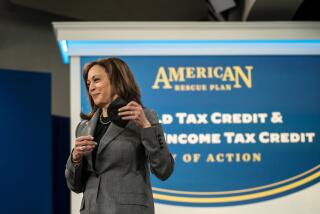Fewer keeping the nation afloat
- Share via
SUE Carpenter pays about $6,100 a year in federal income taxes. But she might owe just half that amount if she had a mortgage, and nothing at all if she had minor children.
The fact that Carpenter doesn’t have these deductions makes her part of a dwindling group: U.S. taxpayers. An estimated 50 million Americans won’t pay any federal income tax this year. That’s nearly a third of all adults, up from 18% in 1980.
To many, the shrinking tax base is not a big deal. Most of the people who don’t owe Uncle Sam are of modest means. They don’t pay because Congress approved tax credits aimed at helping working families and sought to encourage homeownership by making mortgage interest deductible.
But then there are people like Carpenter. She’s not rich, making about $58,000 a year working at the Department of Motor Vehicles office in Commerce. She rents a small apartment in Los Angeles for $1,100 a month, so she doesn’t have a mortgage she can use for a deduction.
“I don’t think it’s fair,” said Carpenter, 61. “But we thrifty people don’t get much sympathy.”
Few would begrudge tax breaks for those who struggle to feed their children and keep a roof over their heads. But at the same time, some fear that the tax-free zone has grown too big and that too many working Americans no longer have a stake in the tax system or efforts to improve it.
“Many people would think if you are a citizen, you ought to have skin in the game, and we have more and more people with no skin in the game,” said Scott Hodge, president of the Tax Foundation, a nonpartisan, conservative-leaning research group. “From a social perspective, we ought to be concerned about that.”
Still, no one expects a big change in the underlying trend, especially because tax breaks are one of the few things that Republicans and Democrats both embrace.
Consider the earned income tax credit for low-income workers, which in some cases allows people to be paid more in “refunds” than they actually paid in taxes.
Republicans like it because it’s a tax cut, not a spending program, and it rewards work. But Democrats like it too because the credit provides more than $30 billion in relief to low-income families.
To be sure, it helps take millions of wage earners off the tax rolls. But a House Democrat was quick to point out that low-income Americans already shoulder a heavy load of taxes -- payroll, sales, excise and others.
“Certainly, they’re not keeping pace with people who are taking great advantage of the Bush tax cuts,” said Rep. Xavier Becerra of Los Angeles, a member of the House Ways and Means Committee. Focusing on their light income tax payments, he said, gives “a skewed picture.”
Indeed, wealthy Americans have benefited more than the poor from the tax cuts implemented under President Bush, said Leonard E. Burman, director of the Tax Policy Center and a senior fellow at the Urban Institute.
The very richest Americans -- those in the top tenth of 1% -- received tax cuts of more than 6% on average, he said. The bottom fifth of earners saw breaks of less than 1%.
“The benefits of the Bush tax cuts have been very tilted toward high-income people,” Burman said.
Measures such as the earned income tax credit have been championed as a means of evening things out a bit. But the effect has been a dizzying array of credits and deductions that almost everyone agrees has made paying taxes numbingly complex.
In 2005, a White House advisory panel proposed an array of changes aimed largely at simplification, including scaling back the mortgage interest deduction that for generations had helped persuade renters to become homeowners.
The panel also called for eliminating deductions for state and local tax payments and restricting tax-free health insurance benefits for employees.
Predictably, the real estate industry, healthcare providers and dozens of other special interests rose up in protest. The proposals went nowhere.
“All the individuals and industries who had favored positions in the tax code screamed because they were going to lose all sorts of benefits,” said Lawrence B. Gibbs, a former Internal Revenue Service commissioner who is now a partner at the Washington law firm of Miller & Chevalier.
Although major tax reform is no longer on the agenda, an emerging debate over the alternative minimum tax is intimately tied to the question of who pays taxes and how much.
The alternative tax was approved in 1969 to make sure that millionaires who exploited loopholes at least paid something. But for technical reasons -- including the lack of provisions to adjust its formula for inflation -- the alternative tax now has a much longer reach.
In the 2007 tax year, it could affect 23 million Americans, some earning as little as $50,000. That’s up from about 4 million in 2006. House Democrats hope to shield taxpayers earning less than $200,000 from getting caught in the alternative-tax trap. But there would be a price. Under new budget rules, Congress would have to make up $1 trillion in lost revenue over the next 10 years to carry out such a fix to the alternative tax.
“They’ve had sort of a picnic in terms of tax cutting, and that picnic may be over soon,” said Max B. Sawicky, an economist at the liberal Economic Policy Institute.
As one response, House Democrats are likely to scrutinize special tax breaks for business with an eye to weeding out “corporate welfare,” Becerra said.
In addition, the Democratic majority has proposed a budget that may let some tax breaks expire when they come up for renewal in 2010, said Chuck Fant, deputy chief of staff for the House Budget Committee. The Democrats are expected to maintain the child tax credit, deductions for state and local sales taxes and some others.
There is no shortage of provisions to examine.
The list of credits, deductions and “income exclusions” stands at 146, up from 67 in 1974. The cost of these breaks have tripled over the period, from $240 billion to $730 billion after adjusting for inflation, a 2005 study by the Government Accountability Office showed.
Having a child, for example, once got you a “personal exemption” deduction, which reduces your taxable income by $3,300. That would save someone who paid 30% of their income in tax about $1,100.
That same kid is worth far more today. In addition to the personal exemption, parents of young children get a “child credit” worth $1,000 in tax savings. If they send a child to day care so both parents can work, they get a credit to offset a portion of their baby-sitting costs too.
It gets better. If the parents can afford to set aside money to pay for their child’s future college bills, they get to exclude the investment income (as long as it’s in a qualified plan). When that son or daughter goes off to college, the parents can choose one of three breaks -- two tax credits and one deduction -- to offset the tuition. Plus, there’s a write-off for interest on student loans.
Homeowners have long been able to deduct their interest payments, regardless of need, and every decade or so the deal has been sweetened.
In 1986, homeowners were allowed to deduct the cost of home equity loans of up to $100,000, no matter the purpose of the loan -- even buying a car or taking a vacation.
In 1997, homeowners got the right to exclude up to $250,000 in gains on the sale of their residence. The deduction is for each owner, so a husband and wife who own a home together could exclude a combined $500,000 in gains.
This year, another break goes into effect. Homeowners will be able to write off the cost of private mortgage insurance.
Critics point out that deductions such as these don’t necessarily go to the needy. But then, whoever said that was the intent?
“We have accepted the idea that our tax system is where we pay for welfare through the earned income tax credit,” said Gibbs, the former IRS commissioner. “We pay for child care, for retirement and healthcare, education programs, homeownership, charitable contributions and investments through preferential rates on capital gains and dividends.
“We even collect from deadbeat dads through refund holdbacks,” he said.
“Nobody is really asking today whether that’s fair. It’s just the way it’s being done.”
*
(BEGIN TEXT OF INFOBOX)
Time’s almost up
Here are a few pointers for last-minute filers.
Deadline: Returns must be postmarked or filed electronically by 11:59 p.m. Tuesday. The usual deadline -- April 15 -- fell on a Sunday this year, and Monday is a District of Columbia holiday.
Late mailing: Many post offices will have extended hours on tax day, with eight Southland locations open until midnight. To find the one nearest you, call (800) 275-8777 (ASK-USPS).
Forms: Forms are often available at public libraries. You can also download them from the IRS website at www.irs.gov.
Help: People earning less than $39,000 a year can get free help filling out their forms by calling the IRS at (800) 829-1040.
--
Source: Times research
More to Read
Get the L.A. Times Politics newsletter
Deeply reported insights into legislation, politics and policy from Sacramento, Washington and beyond. In your inbox three times per week.
You may occasionally receive promotional content from the Los Angeles Times.










